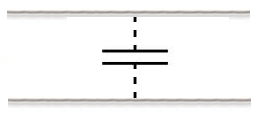What is Stray Capacitance?

Stray capacitance is unintended and unwanted capacitance in a circuit.
Capacitance doesn't exist only within capacitors. In fact, any two surfaces at different electric potential, and that are close enough together to generate an electric field have capacitance, and thus act like a capacitor. Such effects are often present within circuits (for exampl,e between conductive runs or component leads), even though they are not intended. This unintended capaictance is referred to as stray capacitance, and it can result in a disruption of normal current flow within a circuit.
Designers of circuits try to minimize stray capacitance as much as possible. They do this by keeping the leads of electronic components very short and grouping components in such a way to eliminate capacitive coupling.
A good example of this is an inductor. When buying an inductor fresh from
a manufacturer, the leads of the inductor are usually quite long.

The leads can extend for several inches on inductors, as can be seen from the illustration above.
However, plugging an inductor with the leads this long into a circuit can create some issues in the circuit.
When you have inductors that have very long leads close to each other, these leads are, essentially, wires. When you have wires close to each other in circuits, they can produce a capacitive effect. Even a small amount of wire can have considerable capacitance. When you have this, the capacitance can serve to impede or block low-frequency signals. This is because capacitance or a device that acts as an capacitor has high impedance to low-frequency signals. Thus, it is difficult for low-frequency signals to pass through a circuit that exhibits capacitive qualities. When you add unwanted capacitance into a circuit, the circuit can now act (again unwanted) to block low-frequency signals. Thus, an inductor, which is a device that has low reactance, or impedance, at low frequencies, may now impede low-frequency signals from passing through. If this is radio circuit or an audio circuit, entire ranges of frequencies may be blocked, which of course can cause poor transmission of numerous frequencies. This is why it is desired that no stray capacitance exist in a circuit.
Therefore, this is the reason inductor leads must be kept short, less than 1.5mm in length ideally, to effectively stop
capacitive effects, which can limit an inductor's
ability to pass low-frequency signals.

Surface mount inductors are even better to use in circuits because their lead-less terminals being placed directly on the power plane of a
circuit stops almost all
capacitance. This is because surface mount components have no leads, but just terminals. This will limit the inductance that inductors can emit and will allow
them to pass low frequency signals better in a circuit.
Related Resources
What is Stray Inductance?
Capacitors in Series and in Parallel
What does the Voltage Rating on a Capacitor Mean?
Capacitive Reactance
Capacitor Equations
Types of Capacitors
What are Capacitors Used For?
What is a Coupling Capacitor?
What is a Bypass Capacitor?
What is a Smoothing Capacitor?
How to Measure Capacitance
How to Test a Capacitor
